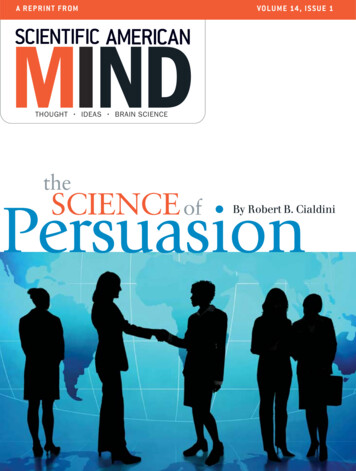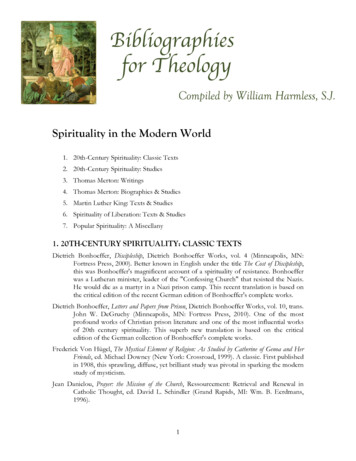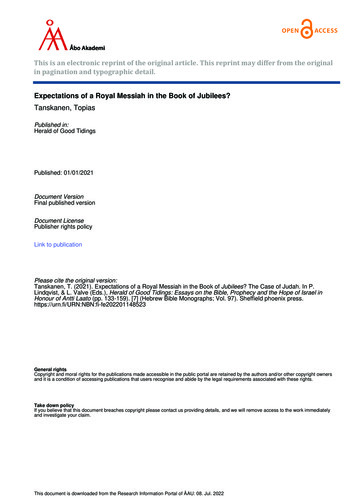
Transcription
A REPRINT FROMVOLUME 14, IS SUE 1MINDTHOUGHT IDEAS BRAIN SCIENCEtheSCIENCE ofPersuasionBy Robert B. Cialdini
By Robert B. CialdinitheSCIENCE ofPersuasionSocial psychology has determinedthe basic principles that governgetting to “yes”Hello there.I hope you’ve enjoyed the magazine so far. Now I’d like to let you in on something of great importance to you personally. Have you ever been tricked into saying yes? Ever felt trapped into buying something you didn’t really want or contributing to some suspicious-sounding cause? And have you ever wishedyou understood why you acted in this way so that you could withstand these clever ploys in the future?Yes? Then clearly this article is just right for you. It contains valuable information on the most powerful psychological pressures that get you to say yes to requests. And it’s chock-full of NEW, IMPROVEDresearch showing exactly how and why these techniques work. So don’t delay, just settle in and get theinformation that, after all, you’ve already agreed you want.The scientific study of the process ofsocial influence has been under wayfor well over half a century, beginning in earnest with the propaganda, public information and persuasion programs of WorldWar II. Since that time, numerous social scientists have investigated the ways in which one individual can influence another’s attitudes and actions. For the past 30 years, I have participatedin that endeavor, concentrating primarily on themajor factors that bring about a specific form ofbehavior change— compliance with a request.Six basic tendencies of human behavior comeinto play in generating a positive response: recip-2rocation, consistency, social validation, liking,authority and scarcity. As these six tendencieshelp to govern our business dealings, our societal involvements and our personal relationships, knowledge of the rules of persuasion cantruly be thought of as empowerment.ReciprocationWhen the Disabled American Veterans organization mails out requests for contributions, theappeal succeeds only about 18 percent of the time.But when the mailing includes a set of free personalized address labels, the success rate almostdoubles, to 35 percent. To understand the effect ofSCIENTIFIC AMERICAN MIND
STEVEN ADAMS AP Photo/Tribune-Reviewthe unsolicited gift, we must recognize the reachand power of an essential rule of human conduct:the code of reciprocity.All societies subscribe to a norm that obligatesindividuals to repay in kind what they have received. Evolutionary selection pressure has probably entrenched the behavior in social animalssuch as ourselves. The demands of reciprocity begin to explain the boost in donations to the veterans group. Receiving a gift— unsolicited and perhaps even unwanted— convinced significant numbers of potential donors to return the favor.Charitable organizations are far from alone intaking this approach: food stores offer free samples, exterminators offer free in-home inspections,www.sciam.comhealth clubs offer free workouts. Customers arethus exposed to the product or service, but theyare also indebted. Consumers are not the onlyones who fall under the sway of reciprocity. Pharmaceutical companies spend millions of dollarsevery year to support medical researchers and toprovide gifts to individual physicians— activitiesthat may subtly influence investigators’ findingsand physicians’ recommendations. A 1998 studyin the New England Journal of Medicine foundthat only 37 percent of researchers who publishedconclusions critical of the safety of calcium channel blockers had previously received drug company support. Among those whose conclusions attested to the drugs’ safety, however, the number ofFree samplescarry a subtleprice tag; theypsychologicallyindebt theconsumer toreciprocate. Hereshoppers getcomplimentarytastes of a newproduct, greenketchup.3
Publiccommitmentof signinga petitioninfluencesthe signerto behaveconsistently withthat position inthe future.FAST FACTSPersuasive Techniques1 Six basic tendencies of human behavior come intoplay in generating a positive response to a request:reciprocation, consistency, social validation, liking, authorityand scarcity.2 Knowledge of these tendencies can empower consumers and citizens to make better-informed decisions about, for example, whether to purchase a product orvote for legislation.3 The six key factors are at work in various areas aroundthe world as well, but cultural norms and traditionscan modify the weight brought to bear by each factor.4For another random sample of passersby,however, we began with an even larger request: toserve as an unpaid counselor at the center for twohours per week for the next two years. Everyonein this second sampling rejected the extreme appeal. At that point we offered them a concession.“If you can’t do that,” we asked, “would youchaperone a group of juvenile detention center inmates on a day trip to the zoo?” Our concessionpowerfully stimulated return concessions. Thecompliance rate nearly tripled, to 50 percent, compared with the straightforward zoo-trip request.ConsistencyIn 1998 Gordon Sinclair, the owner of a wellknown Chicago restaurant, was struggling with aproblem that afflicts all restaurateurs. Patrons frequently reserve a table but, without notice, fail toappear. Sinclair solved the problem by asking hisreceptionist to change two words of what she saidto callers requesting reservations. The changedropped his no-call, no-show rate from 30 to 10percent immediately.The two words were effective because theycommissioned the force of another potent humanmotivation: the desire to be, and to appear, consistent. The receptionist merely modified her request from “Please call if you have to change yourplans” to “Will you please call if you have tochange your plans?” At that point, she politelypaused and waited for a response. The wait waspivotal because it induced customers to fill thepause with a public commitment. And public commitments, even seemingly minor ones, direct future action.In another example, Joseph Schwarzwald ofSCIENTIFIC AMERICAN MINDLUIS M. ALVAREZ AP Photothose who had received free trips, research funding or employment skyrocketed— to 100 percent.Reciprocity includes more than gifts and favors;it also applies to concessions that people make toone another. For example, assume that you rejectmy large request, and I then make a concession toyou by retreating to a smaller request. You mayvery well then reciprocate with a concession of yourown: agreement with my lesser request. In the mid1970s my colleagues and I conducted an experiment that clearly illustrates the dynamics of reciprocal concessions. We stopped a random sample ofpassersby on public walkways and asked them ifthey would volunteer to chaperone juvenile detention center inmates on a day trip to the zoo. As expected, very few complied, only 17 percent.
Bar-Ilan University in Israel and his co-workersnearly doubled monetary contributions for thehandicapped in certain neighborhoods. The keyfactor: two weeks before asking for contributions,they got residents to sign a petition supporting thehandicapped, thus making a public commitmentto that same cause.FOREST SERVICE–USDASocial ValidationOn a wintry morning in the late 1960s, a manstopped on a busy New York City sidewalk andgazed skyward for 60 seconds, at nothing in particular. He did so as part of an experiment by CityUniversity of New York social psychologists Stanley Milgram, Leonard Bickman and LawrenceBerkowitz that was designed to find out what effect this action would have on passersby. Mostsimply detoured or brushed by; 4 percent joinedthe man in looking up. The experiment was thenrepeated with a slight change. With the modification, large numbers of pedestrians were induced tocome to a halt, crowd together and peer upward.The single alteration in the experiment incorporated the phenomenon of social validation. Onefundamental way that we decide what to do in asituation is to look to what others are doing orhave done there. If many individuals have decidedin favor of a particular idea, we are more likely tofollow, because we perceive the idea to be morecorrect, more valid.Milgram, Bickman and Berkowitz introducedthe influence of social validation into their streetexperiment simply by having five men rather thanone look up at nothing. With the larger initial setof upward gazers, the percentage of New Yorkers who followed suit more than quadrupled, to18 percent. Bigger initial sets of planted up-lookers generated an even greater response: a startergroup of 15 led 40 percent of passersby to join in,nearly stopping traffic within one minute.Taking advantage of social validation, requesters can stimulate our compliance by demonstrating (or merely implying) that others just likeus have already complied. For example, a studyfound that a fund-raiser who showed homeowners a list of neighbors who had donated to a localcharity significantly increased the frequency ofcontributions; the longer the list, the greater the effect. Marketers, therefore, go out of their way toinform us when their product is the largest-sellingor fastest-growing of its kind, and television commercials regularly depict crowds rushing to storesto acquire the advertised item.Less obvious, however, are the circumstancesunder which social validation can backfire to pro-www.sciam.comduce the opposite of what a requester intends. Anexample is the understandable but potentially misguided tendency of health educators to call attention to a problem by depicting it as regrettably frequent. Information campaigns stress that alcoholand drug use is intolerably high, that adolescentsuicide rates are alarming and that polluters arespoiling the environment. Although the claims areboth true and well intentioned, the creators ofthese campaigns have missed something basicabout the compliance process. Within the statement “Look at all the people who are doing thisundesirable thing” lurks the powerful and undercutting message “Look at all the people who aredoing this undesirable thing.” Research showsthat, as a consequence, many such programsboomerang, generating even more of the undesirable behavior.For instance, a suicide intervention programadministered to New Jersey teenagers informedthem of the high number of teenage suicides.Health researcher David Shaffer and his colleaguesat Columbia University found that participants became significantly more likely to see suicide as apotential solution to their problems. Of greater effectiveness are campaigns that honestly depict theunwanted activity as damaging despite the factthat relatively few individuals engage in it.Liking“Affinity,” “rapport” and “affection” all describe a feeling of connection between people. Butthe simple word “liking” most faithfully capturesthe concept and has become the standard designation in the social science literature. People prefer to say yes to those they like. Consider theworldwide success of the Tupperware Corporation and its “home party” program. Through thein-home demonstration get-together, the company arranges for its customers to buy from a likedfriend, the host, rather than from an unknownsalesperson. So favorable has been the effect onproceeds that, according to company literature, aTupperware party begins somewhere in the worldevery two seconds. In fact, 75 percent of all Tupperware parties today occur outside the individualistic U.S., in countries where group social bonding is even more important than it is here.Of course, most commercial transactions takeplace beyond the homes of friends. Under thesemuch more typical circumstances, those who wishto commission the power of liking employ tacticsclustered around certain factors that research hasshown to work.Physical attractiveness can be such a tool. In aSocial validationtakes advantage ofpeer pressure todrive humanbehavior. Poorlyapplied, however,it can alsoundermineattempts to curtaildeleteriousactivities, bypointing out theirubiquity: Ifeveryone’s doingit, why shouldn’t I?5
(Are we then doomed to be helplesslymanipulated by these principles? No.Behold the powerof authority.Certainly not loston the NationalRifle Association isthat the authorityinherent in suchheroic figures asMoses, El Cid andBen-Hur is linkedto the actor whoportrayed them,Charlton Heston.6quests, the amount of the donations more thandoubled.Compliments also stimulate liking, and directsalespeople are trained in the use of praise. Indeed,even inaccurate praise may be effective. Researchat the University of North Carolina at Chapel Hillfound that compliments produced just as muchliking for the flatterer when they were untrue aswhen they were genuine.tractive candidates several times as many votes asunattractive ones. Yet such voters insisted thattheir choices would never be influenced by something as superficial as appearance.Similarity also can expedite the developmentof rapport. Salespeople often search for, or outright fabricate, a connection between themselvesand their customers: “Well, no kidding, you’refrom Minneapolis? I went to school in Minnesota!” Fund-raisers do the same, with good results.In 1994 psychologists R. Kelly Aune of the University of Hawaii at Manoa and Michael D. Basilof the University of Denver reported research inwhich solicitors canvassed a college campus asking for contributions to a charity. When thephrase “I’m a student, too” was added to the re-)Cooperation is another factor that has beenshown to enhance positive feelings and behavior.Salespeople, for example, often strive to be perceived by their prospects as cooperating partners.Automobile sales managers frequently cast themselves as “villains” so the salesperson can “do battle” on the customer’s behalf. The gambit naturally leads to a desirable form of liking by the customer for the salesperson, which promotes sales.AuthorityRecall the man who used social validation toget large numbers of passersby to stop and stare atthe sky. He might achieve the opposite effect andspur stationary strangers into motion by assumingthe mantle of authority. In 1955 University ofTexas at Austin researchers Monroe Lefkowitz,Robert R. Blake and Jane S. Mouton discoveredthat a man could increase by 350 percent the number of pedestrians who would follow him acrossthe street against the light by changing one simplething. Instead of casual dress, he donned markersof authority: a suit and tie.Those touting their experience, expertise orscientific credentials may be trying to harness thepower of authority: “Babies are our business, ouronly business,” “Four out of five doctors recommend,” and so on. (The author’s biography on theopposite page in part serves such a purpose.) Thereis nothing wrong with such claims when they arereal, because we usually want the opinions of trueauthorities. Their insights help us choose quicklyand well.The problem comes when we are subjected tophony claims. If we fail to think, as is often thecase when confronted by authority symbols, wecan easily be steered in the wrong direction by ersatz experts— those who merely present the auraof legitimacy. That Texas jaywalker in a suit andtie was no more an authority on crossing the streetSCIENTIFIC AMERICAN MINDRIC FELD AP Photo1993 study conducted by Peter H. Reingen of Arizona State University and Jerome B. Kernan, nowat George Mason University, good-looking fundraisers for the American Heart Association generated nearly twice as many donations (42 versus23 percent) as did other requesters. In the 1970sresearchers Michael G. Efran and E.W.J. Patterson of the University of Toronto found that votersin Canadian federal elections gave physically at-
than the rest of the pedestrians who nonethelessfollowed him. A highly successful ad campaign inthe 1970s featured actor Robert Young proclaiming the health benefits of decaffeinated coffee.Young seems to have been able to dispense thismedical opinion effectively because he represented, at the time, the nation’s most famous physician. That Marcus Welby, M.D., was only a character on a TV show was less important than theappearance of authority.iStockScarcityWhile at Florida State University in the 1970s,psychologist Stephen West noted an odd occurrence after surveying students about the campuscafeteria cuisine: ratings of the food rose significantly from the week before, even though therehad been no change in the menu, food quality orpreparation. Instead the shift resulted from an announcement that because of a fire, cafeteria mealswould not be available for several weeks.This account highlights the effect of perceivedscarcity on human judgment. A great deal of evidence shows that items and opportunities becomemore desirable to us as they become less available.www.sciam.comFor this reason, marketers trumpet the uniquebenefits or the one-of-a-kind character of their offerings. It is also for this reason that they consistently engage in “limited time only” promotionsor put us into competition with one another using sales campaigns based on “limited supply.”Less widely recognized is that scarcity affectsthe value not only of commodities but of information as well. Information that is exclusive ismore persuasive. Take as evidence the dissertationdata of a former student of mine, Amram Knishinsky, who owned a company that imported beefinto the U.S. and sold it to supermarkets. To examine the effects of scarcity and exclusivity oncompliance, he instructed his telephone sales-Friends (who arealready liked) arepowerful salespeople, as Tupperware Corporationdiscovered.Strangers canco-opt the trappings of friendshipto encouragecompliance.(The Author)ROBERT B. CIALDINI is Regents’ Professor of Psychology at Arizona State University, where he has also been named Distinguished Graduate Research Professor. He is past president of the Society of Personality and Social Psychology.Cialdini’s book Influence, which was the result of a three-year study of the reasons why people comply with requests in everyday settings, has appeared innumerous editions and been published in nine languages. He attributes his longstanding interest in the intricacies of influence to the fact that he was raised inan entirely Italian family, in a predominantly Polish neighborhood, in a historically German city (Milwaukee), in an otherwise rural state.7
people to call a randomly selected sample of customers and to make a standard request of them topurchase beef. He also instructed the salespeopleto do the same with a second random sample ofcustomers but to add that a shortage of Australianbeef was anticipated, which was true, because ofcertain weather conditions there. The added information that Australian beef was soon to bescarce more than doubled purchases.Finally, he had his staff call a third sample ofcustomers, to tell them (1) about the impendingshortage of Australian beef and (2) that this information came from his company’s exclusivesources in the Australian national weather service.These customers increased their orders by morethan 600 percent. They were influenced by ascarcity double whammy: not only was the beefscarce, but the information that the beef wasscarce was itself scarce.Knowledge Is PowerI think it noteworthy that many of the datapresented in this article have come from studies ofthe practices of persuasion professionals— themarketers, advertisers, salespeople, fund-raisersand their comrades whose financial well-being de-(Influence across Cultures)o the six key factors in the social influenceprocess operate similarly across nationalboundaries? Yes, but with a wrinkle. Thecitizens of the world are human, after all, andsusceptible to the fundamental tendencies thatcharacterize all members of our species. Cultural norms, traditions and experiences can, however, modify the weight that is brought to bear byeach factor.Consider the results of a report published in2000 by Stanford University’s Michael W. Morris,Joel M. Podolny and Sheira Ariel, who studiedemployees of Citibank, a multinational financialcorporation. The researchers selected four societies for examination: the U.S., China, Spain andGermany. They surveyed Citibank branches within each country and measured employees’ willingness to comply voluntarily with a request froma co-worker for assistance with a task. Althoughmultiple key factors could come into play, themain reason employees felt obligated to complydiffered in the four nations. Each of these reasons incorporated a different fundamental principle of social influence.Employees in the U.S. took a reciprocationbased approach to the decision to comply. Theyasked the question, “What has this person donefor me recently?” and felt obligated to volunteerif they owed the requester a favor. Chinese employees responded primarily to authority, in theform of loyalties to those of high status withintheir small group. They asked, “Is this requesterconnected to someone in my unit, especiallysomeone who is high-ranking?” If the answer wasyes, they felt required to yield.Spanish Citibank personnel based the deci-D8sion to comply mostly on liking/friendship. Theywere willing to help on the basis of friendshipnorms that encourage faithfulness to one’sfriends, regardless of position or status. Theyasked, “Is this requester connected to myfriends?” If the answer was yes, they were especially likely to want to comply.German employees were most compelled byconsistency, offering assistance in order to beconsistent with the rules of the organization.They decided whether to comply by asking, “According to official regulations and categories, amI supposed to assist this requester?” If the answer was yes, they felt a strong obligation togrant the request.In sum, although all human societies seemto play by the same set of influence rules, theweights assigned to the various rules can differacross cultures. Persuasive appeals to audiences in distinct cultures need to take such dif— R.B.C.ferences into account.SCIENTIFIC AMERICAN MINDDUSAN PETRICICCultural norms can alter perceptions ofpersuasion tactics.
PETER BARRERAS AP Photopends on their ability to get others to say yes. Akind of natural selection operates on these people,as those who use unsuccessful tactics soon go outof business. In contrast, those using proceduresthat work well will survive, flourish and pass onthese successful strategies [see “The Power ofMemes,” by Susan Blackmore; Scientific American, October 2000]. Thus, over time, the mosteffective principles of social influence will appearin the repertoires of long-standing persuasion professions. My own work indicates that those principles embody the six fundamental human tendencies examined in this article: reciprocation,consistency, social validation, liking, authorityand scarcity.From an evolutionary point of view, each ofthe behaviors presented would appear to havebeen selected for in animals, such as ourselves, thatmust find the best ways to survive while living insocial groups. And in the vast majority of cases,these principles counsel us correctly. It usuallymakes great sense to repay favors, behave consistently, follow the lead of similar others, favor therequests of those we like, heed legitimate authorities and value scarce resources. Consequently, influence agents who use these principles honestlydo us a favor. If an advertising agency, for instance, focused an ad campaign on the genuineweight of authoritative, scientific evidence favoring its client’s headache product, all the right people would profit— the agency, the manufacturerand the audience. Not so, however, if the agency,finding no particular scientific merit in the pain reliever, “smuggles” the authority principle into thesituation through ads featuring actors wearingwhite lab coats.Are we then doomed to be helplessly manipulated by these principles? No. By understandingpersuasion techniques, we can begin to recognizestrategies and thus truly analyze requests and offerings. Our task must be to hold persuasion professionals accountable for the use of the six powerful motivators and to purchase their productsand services, support their political proposals ordonate to their causes only when they have actedtruthfully in the process.If we make this vital distinction in our dealingswith practitioners of the persuasive arts, we willrarely allow ourselves be tricked into assent. Instead we will give ourselves a much better option:to be informed into saying yes. Moreover, as longas we apply the same distinction to our own attempts to influence others, we can legitimatelycommission the six principles. In seeking to persuade by pointing to the presence of genuine ex-www.sciam.compertise, growing social validation, pertinent commitments or real opportunities for cooperation,and so on, we serve the interests of both partiesand enhance the quality of the social fabricin the bargain.Surely, someone with your splendid intellectcan see the unique benefits of this article. And because you look like a helpful person who wouldwant to share such useful information, let memake a request. Would you buy this issue of themagazine for 10 of your friends? Well, if you can’tdo that, would you show it to just one friend?Wait, don’t answer yet. Because I genuinely likeyou, I’m going to throw in— at absolutely no extra cost— a set of references that you can consultto learn more about this little-known topic.Now, will you voice your commitment tohelp?. . . Please recognize that I am pausing politely here. But while I’m waiting, I want you tofeel totally assured that many others just like youwill certainly consent. And I love that shirt you’rewearing.Limited offer oftoys available fora short time oftencreates a figurativefeeding frenzy atlocal fast-foodestablishments.Scarcity can bemanufactured tomake a commodityappear moredesirable.(Further Reading) Bargaining for Advantage. G. Richard Shell. Viking, 1999. Age of Propaganda: The Everyday Use and Abuse of Persuasion. Revisededition. A. J. Pratkanis and E. Aronson. W. H. Freeman and Company, 2001. Influence: Science and Practice. Fourth edition. Robert B. Cialdini.Allyn & Bacon, 2001. The Power of Persuasion: How We’re Bought and Sold. Robert Levine.John Wiley & Sons, 2003. For regularly updated information about the social influence process, visitwww.influenceatwork.com9
VOL. 14, NO. 1 PAGES 70 THRU 77 Copyright 2007 Scientific American, Inc. All rights reserved. Printed in the U.S.A. No part of thisreprint may be reproduced by any mechanical, photographic or electronic process, or in the form of a phonographic recording, normay it be stored in a retrieval system, transmitted or otherwise copied for public or private use without written permission of the publisher. The trademark and tradename “SCIENTIFIC AMERICAN” and the distinctive logotype pertaining thereto are the sole property ofand are registered under the name of Scientific American, Inc. Page numbers and internal references may vary from those in original issues.
2 SCIENTIFIC AMERICAN MIND PersuasionSCIENCEof the By Robert B. Cialdini Social psy chology has determined the basic principles that govern getting to "yes" Hello there. I hope you've enjoyed the magazine so far. Now I'd like to let you in on something of great impor-tance to you personally. Have you ever been tricked into saying yes?











